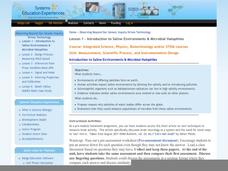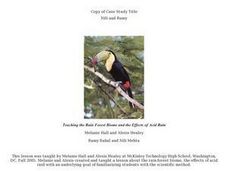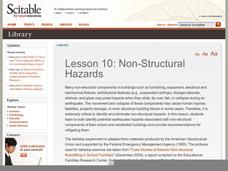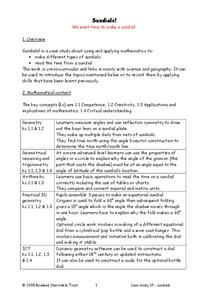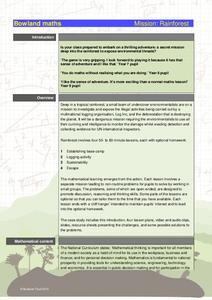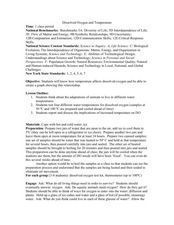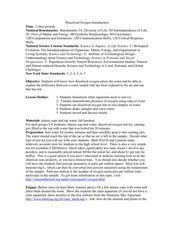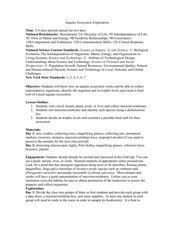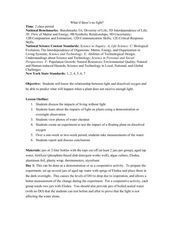National Center for Case Study Teaching in Science
Bad Fish, Bad Bird
In an advanced biology lesson, learners see a PowerPoint about biologist Dr. Westwood, a two-time victim of poisoning. Designed to be used with clickers in the classroom, you could modify the lesson by creating a worksheet from the...
National Center for Case Study Teaching in Science
The Zarkah Stone
Astronomy stars read the account of the Zarkah meteorite that struck thickly populated Park Forest, Chicago in 2003. In doing so, they differentiate between meteors, meteorites, and meteoroids. They will also be able to explain...
Curated OER
Capitalization in Sentences
Woah, these sentences need some capitals! Learners examine 10 incorrect sentences to determine which letters should be capitalized. They circle names, restaurants, sentence-starters, titles, planets, days of the week, locations, and...
Institute for Systems Biology
Introduction to Saline Environments & Microbial Halophiles
If you do not mind wading through unrelated headings (This is not for a physics or STEM course, as it states.) and content (The lesson opens with an article about neurology, not halophiles.), then you will find a valuable resource on...
Curated OER
Rain Forest Biome and the Effects of Acid Rain
Students examine how acid rain affects the rain forest. They identify the causes of acid rain, determine how human behavior can affect the environment and discuss ways to prevent acid rain and acid rain damage to the rain forest.
Curated OER
Gravity Versus the Mighty Egg
Students design, revise and construct a method for protecting an egg from cracking when it is dropped from a height. They work in small groups to develop their protection method and then collect and analyze data as a class when each...
Curated OER
Cellular Models
Each student construct a model of a cell on a large cookie, including the parts which were discussed during lecture.? Half of the class will be instructed to make plant cell models and the other half will be in charge of animal cell...
Nature
Non-Structural Hazards
Buildings often have decorative components and furnishings that can pose a hazard during an earthquake. Learners examine the classroom for such non-structural features. They consider fictional scenarios and discuss what actions...
Howard Hughes Medical Institute
The Molecular Evolution of Gene Birth and Death
An upper-level biology activity, the comprehensive worksheet found here accompanies a PowerPoint and the video The Making of the Fittest: The Birth and Death of Genes, both of which are linked to through the website. Depending on the...
Curated OER
Agriculture in Canada
Students examine various elements in the physical environment and their relationship to agriculture in Canada. Using the ArcCanada CD-ROM, they analyze maps, and interpret relationships between the physical environment and land use.
Curated OER
Trivia Tag
Learners, as chasers, on teachers signal, move throughout a space trying to tag others with their free hand. When a tag is made, both players stop; chaser reads question from card to student who was tagged. If answer is correct, person...
Curated OER
Similarities Attract
Students research all the ways people seek their soulmates. The question if opposites attract or those with similar attractions is studied in depth. Compile all the many steps a scientist must often take to answer what looks like a...
Curated OER
Use It or Lose It
Students explore the effects of resistance training on the muscles. Data on the muscle mass of rats is examined is graphed to determine any increase in mass due to training.
Curated OER
Illuminating Climate Change: Connecting Lighting and Global Warming
High schoolers analyze energy usage and connect energy usage to fossil fuel consumption. In this global warming and pollution lesson plan, students what fuels are used to generate electricity and how much CO2 each fuel produces, then...
Curated OER
Chemicals, Chemicals, Everywhere
Students divide substances into categories: made of chemicals/not made of chemicals, synthetic/naturally occurring, and toxic/nontoxic. They observe a mystery chemical and determine what precautions they need to take when handling an...
Bowland
Sundials!
Time to learn about sundials. Scholars see how to build sundials after learning about Earth's rotation and its relation to time. The unit describes several different types of possible sundials, so choose the one that fits your needs — or...
Bowland
Mission: Rainforest
Young environmentally conscious mathematicians solve a variety of problems related to the central theme of uncovering illegal logging activities. They determine a base camp based on given constraints, investigate logging activities and...
Constitutional Rights Foundation
Immigration Enforcement Raids
Class groups take on the role of advisors to the Assistant Secretary of the Office of Policy & Planning of ICE. Their charge is to prepare a report for the secretary on the effectiveness of enforcement actions of the ICE in...
Mathematics Vision Project
Quadratic Equations
Through a variety of physical and theoretical situations, learners are led through the development of some of the deepest concepts in high school mathematics. Complex numbers, the fundamental theorem of algebra and rational exponents...
Curated OER
Dissolved Oxygen and Temperature
Learners are shown how temperature affects dissolved oxygen and they create a graph showing this relationship. They think about the adaptations of animals to live in different water temperatures. Students test four different water...
Curated OER
Dissolved Oxygen Introduction
High schoolers are shown how dissolved oxygen enters the water. They are taught the difference between a water sample that has been exposed to the air and one that has not. Students brainstorm what organisms need to survive. They use...
Curated OER
Is Our Water Healthy?
High schoolers test water for a least one chemical characteristic. They hypothesize how a storm event might change the chemical characteristics of a stream. Students collect water samples and use the chemical test to test the water.
Curated OER
Aquatic Ecosystem Exploration
Young scholars visit a local stream, pond, creek, or river and collect macroinvertebrates. They sort macroinvertebrates and identify each species using a dichotomous key. Students decide on trophic levels and construct a possible food...
Curated OER
What If There's No Light?
young scholars discuss the importance of light and the consequences of living without it. Using a plant as a demonstration, students predict and observe what happens to a plant when it does not receive enough light. In groups, they...



